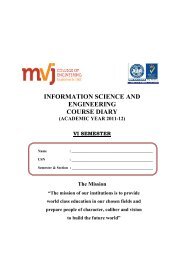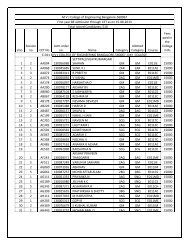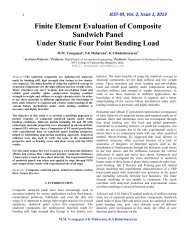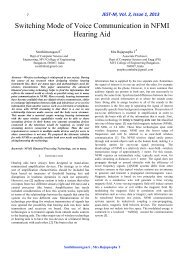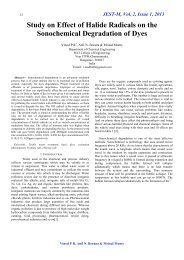IEEE Paper Template in A4 (V1) - MVJ College of Engineering
IEEE Paper Template in A4 (V1) - MVJ College of Engineering
IEEE Paper Template in A4 (V1) - MVJ College of Engineering
Create successful ePaper yourself
Turn your PDF publications into a flip-book with our unique Google optimized e-Paper software.
43 JEST-M, Vol.1, Issue 2, 2012endothelial cell, which might be <strong>of</strong> low contrast and somewhatblurred. Reduc<strong>in</strong>g the noise and blurr<strong>in</strong>g and <strong>in</strong>creas<strong>in</strong>g thecontrast range could enhance the image. The orig<strong>in</strong>al imagemight have areas <strong>of</strong> very high and very low <strong>in</strong>tensity, whichmask details. An adaptive enhancement algorithm revealsthese details. Adaptive algorithms adjust their operation basedon the image <strong>in</strong>formation (pixels) be<strong>in</strong>g processed. In this casethe mean <strong>in</strong>tensity, contrast, and sharpness (amount <strong>of</strong> blurremoval) could be adjusted based on the pixel<strong>in</strong>tensitystatistics <strong>in</strong> various areas <strong>of</strong> theThe follow<strong>in</strong>g shows the histogram equalization<strong>of</strong> an arbitrary histogram.Methods <strong>of</strong> Image Enhancement1) Histogram EqualizationThis method usually <strong>in</strong>creases the global contrast<strong>of</strong> many images, especially when the usable data<strong>of</strong> the image is represented by close contrastvalues. Through this adjustment, the <strong>in</strong>tensitiescan be better distributed on the histogram. Thisallows for areas <strong>of</strong> lower local contrast to ga<strong>in</strong> ahigher contrast. Histogram equalizationaccomplishes this by effectively spread<strong>in</strong>g out themost frequent <strong>in</strong>tensity values.The method is useful <strong>in</strong> images with backgroundsand foregrounds that are both bright or both dark.In particular, the method can lead to better views<strong>of</strong> bone structure <strong>in</strong> x-ray images, and to betterdetail <strong>in</strong> photographs that are over or underexposed.A key advantage <strong>of</strong> the method is that itis a fairly straightforward technique and an<strong>in</strong>vertible operator. So <strong>in</strong> theory, if the histogramequalization function is known, then the orig<strong>in</strong>alhistogram can be recovered. A disadvantage <strong>of</strong>the method is that it is <strong>in</strong>discrim<strong>in</strong>ate. It may<strong>in</strong>crease the contrast <strong>of</strong> background noise, whiledecreas<strong>in</strong>g the usable signal.Fig2-histogram equalization2) Gamma Correction Gamma correction, gamma nonl<strong>in</strong>earity, gammaencod<strong>in</strong>g, or <strong>of</strong>ten simply gamma, is the name <strong>of</strong>a nonl<strong>in</strong>ear operation used to code and decodelum<strong>in</strong>ance or tristimulus values <strong>in</strong> video or stillimage systems. [1] Gamma correction is, <strong>in</strong> thesimplest cases, def<strong>in</strong>ed by the follow<strong>in</strong>g powerlawexpression: where the <strong>in</strong>put and output values are nonnegativereal values, typically <strong>in</strong> a predeterm<strong>in</strong>edrange such as 0 to 1. A gamma value issometimes called an encod<strong>in</strong>g gamma, and theprocess <strong>of</strong> encod<strong>in</strong>g with this compressivepower-law nonl<strong>in</strong>earity is called gammaKavitha Ramasamy
45 JEST-M, Vol.1, Issue 2, 2012Fig-4 plot <strong>of</strong> Homomorphic filter<strong>in</strong>gRet<strong>in</strong>ex MethodsIII.RETINEX THEORYThe orig<strong>in</strong>al aim <strong>of</strong> the theory is a computationalmodel <strong>of</strong> human vision, but it has also been used and extendedfor mach<strong>in</strong>e vision. In theory, most versions <strong>of</strong> Ret<strong>in</strong>ex arerobust with respect to slowly spatially vary<strong>in</strong>g illum<strong>in</strong>ation,R ( x,y)although test<strong>in</strong>g on real images has been limited to sceneswhere the illum<strong>in</strong>ation has been controlled to be quite uniform.Nonetheless, the vary<strong>in</strong>g illum<strong>in</strong>ation component <strong>of</strong> this workis both <strong>in</strong>terest<strong>in</strong>g and important. In Ret<strong>in</strong>ex based methods,vary<strong>in</strong>g illum<strong>in</strong>ation is discounted by assum<strong>in</strong>g that smallspatial changes <strong>in</strong> the responses are due to changes <strong>in</strong> theillum<strong>in</strong>ation whereas large changes are due to surfaceschanges. The goal <strong>of</strong> Ret<strong>in</strong>ex is to estimate the lightness <strong>of</strong> asurface <strong>in</strong> each channel by compar<strong>in</strong>g the quantum catch ateach pixel or photoreceptor to the value <strong>of</strong> some statisticorig<strong>in</strong>ally the maximumÑ found by look<strong>in</strong>g at a large areaaround the pixel or photoreceptor. The ratios <strong>of</strong> thesequantities (or their logarithms) are the descriptors <strong>of</strong> <strong>in</strong>terest,and thus the method implicitly assumes the diagonal model.Implementation <strong>of</strong> Ret<strong>in</strong>ex ModelIn this paper, we will implement SSR, MSR, andMSRCR with ga<strong>in</strong>/<strong>of</strong>fset. We adjust the ga<strong>in</strong>/<strong>of</strong>fsetparameters to adjust most <strong>of</strong> the pixels values to displaydoma<strong>in</strong> and clap small part <strong>of</strong> the values to improve thecontrast. Comparisons with other image enhancementtechniques will be made.1. S<strong>in</strong>gle-scale ret<strong>in</strong>ex (SSR)The S<strong>in</strong>gle-scale ret<strong>in</strong>ex is given byRi( x,y)logIi(x,y)log[F(x,y)*Ii(x,y)]Where Ii(x,y) is image distribution <strong>in</strong> the ith color band,F(x,y) is the normalized surround function. F ( x,y)dxdy 1(2)The image distribution is the product <strong>of</strong> scenes reflectanceand illum<strong>in</strong>ation (3)Where Si(x,y) is the spatial distribution <strong>of</strong> illum<strong>in</strong>ationand ri(x,y), the distribution <strong>of</strong> scene reflectances. Theconvolution with surround function works as averag<strong>in</strong>g <strong>in</strong> theneighborhood. So thatGenerally the illum<strong>in</strong>ation has slow spatial variation, whichmeansThen it will be apparent that color constancy ( i.e.,<strong>in</strong>dependence from source illum<strong>in</strong>ation spectral and spatialvariation) is achievedVarious surround function could be used. Landproposed an <strong>in</strong>verse square spatial surround function,parameter,Si(x,y)ri(x,y)logSi(x,y)ri(x,y)i (4)Si( x,y) Si(x,y)Moore suggested the exponential formula with absoluteAnd Hurlbert studied the Gaussian,(5)ri(x,y)Ri(x,y) log(6)ri(x,y)2F( x,y) 1/ r(7)F( x,y)exp(r/ c)(8)2 2F(x,y) K exp( r/ c )(9)Kavitha Ramasamy
47 JEST-M, Vol.1, Issue 2, 20125. Comparison with other state <strong>of</strong> art image process<strong>in</strong>gtechniquesIn order to analyze the advantages <strong>of</strong> the Ret<strong>in</strong>ex imageenhancement techniques, we compare the ret<strong>in</strong>ex result withother image enhancement techniques, <strong>in</strong>clud<strong>in</strong>g autoga<strong>in</strong>/<strong>of</strong>fset, gama correction, histogram equalization andhomomorphic filter<strong>in</strong>g. As a result, all the other techniquesheavily depend on <strong>in</strong>put images. For auto ga<strong>in</strong>/<strong>of</strong>fset, it couldachieve dynamic range compression but at the loss <strong>of</strong> detailsdue to saturation and clipp<strong>in</strong>g. For gama correction, it is goodto improve pictures either too dark or too bright but it is aglobal function applied to the picture, thus there is no detailsenhancement <strong>in</strong>volved. For histogram equalization andhomomorphic filter<strong>in</strong>g, they all failed for bi-modal pictures,which <strong>in</strong>cludes the <strong>in</strong>formation both dark and bright areas. (AsFig.8 but they all could achieve some better effect for Fig.9s<strong>in</strong>ce the picture is <strong>in</strong> a general dark situation. But for ret<strong>in</strong>ex,it could achieve satisfactory results for both pictures, thus itsbenefits are obviously to see.IV. CONCLUSIONMultiscale ret<strong>in</strong>ex is an effective algorithm <strong>of</strong> ret<strong>in</strong>ex.It can have dynamic range compression and color renditioneffects at the same time. For color images, color restoration isnecessary <strong>in</strong> the case that the three-color channels are not<strong>in</strong>tensity balanced. The ga<strong>in</strong>/<strong>of</strong>fset processes are used to shift,compress and clip the output <strong>of</strong> MSRCR to the displaydoma<strong>in</strong>, which will improve the contrast. And one <strong>of</strong> theimportant characteristics <strong>of</strong> MSRCR with ga<strong>in</strong>/<strong>of</strong>fsetalgorithms is ―canonical‖, which means that the parameters <strong>of</strong>number <strong>of</strong> scales, scales, ga<strong>in</strong> and <strong>of</strong>fsets do not vary fromimage to image or between band to band.As compared with other image enhancementtechniques, the Ret<strong>in</strong>ex enhancement has the follow<strong>in</strong>gadvantage: ―Canonical‖ constant – once it is def<strong>in</strong>ed,image enhancement is an automatic process<strong>in</strong>dependent <strong>of</strong> <strong>in</strong>puts; Has general application on all pictures; Good dynamic range compression andcolor rendition effect.For the future work, the color image should befurther analyzed. Study the chapter 6 <strong>of</strong> the textbook ―DigitalImage Process<strong>in</strong>g‖, try to analyze the color model suitable forthe ret<strong>in</strong>ex enhancement to improve the color correctionfunction (Ci(x,y)) to achieve the better color rendition, at thesame time, the empirical values <strong>of</strong> ga<strong>in</strong> (G), <strong>of</strong>fset (b) couldalso be improved.Model<strong>in</strong>g scene illum<strong>in</strong>ation is an important problem<strong>in</strong> computer vision. This claim is supported by the existence<strong>of</strong> a large body <strong>of</strong> work address<strong>in</strong>g this problem. This workhas lead to improvements <strong>in</strong> image understand<strong>in</strong>g, objectrecognition, image <strong>in</strong>dex<strong>in</strong>g, image reproduction, and imageenhancement. Nonetheless, much more work is required. Onema<strong>in</strong> problem is the development <strong>of</strong> algorithms for real imagedata. Most <strong>of</strong> the algorithms discussed above have quitespecific requirements for good results, and those requirementsare not met <strong>in</strong> most real images.Furthermore, even if the requirements are met, theyare not verifiable. Prelim<strong>in</strong>ary work suggests that the key toprogress is better overall models which <strong>in</strong>clude more <strong>of</strong> thephysical processes which impact the images. For example, bymodel<strong>in</strong>g vary<strong>in</strong>g illum<strong>in</strong>ation, algorithms have beendeveloped which are not only robust with respect to vary<strong>in</strong>gillum<strong>in</strong>ation, but can use the vary<strong>in</strong>g illum<strong>in</strong>ation for betterperformance.The same applies to specular reflection. Models forreal images must be comprehensive, because we cannotalways rely on the existence <strong>of</strong> certa<strong>in</strong> clues such as vary<strong>in</strong>gillum<strong>in</strong>ation or specularities. Furthermore, both these casesKavitha Ramasamy
48 JEST-M, Vol.1, Issue 2, 2012have connections to other computer vision problems such assegmentation and determ<strong>in</strong><strong>in</strong>g scene geometry from imagedata. Invariably, progress <strong>in</strong> these areas both aids model<strong>in</strong>gthe scene illum<strong>in</strong>ation, and is aided by model<strong>in</strong>g the sceneillum<strong>in</strong>ation. Thus there are great opportunities for progressus<strong>in</strong>g more sophisticated and comprehensive physics basesmodels <strong>of</strong> the <strong>in</strong>teraction <strong>of</strong> scene with illum<strong>in</strong>ation.Snapshots <strong>of</strong> ResultsThe Input Image.Enhanced Image us<strong>in</strong>g ret<strong>in</strong>exScale=2W1=0.8,E2=0.2;C1=270,c2=10;Enhanced Image us<strong>in</strong>g ret<strong>in</strong>exScale=1W1=1;C1=270;Enhanced Image us<strong>in</strong>g ret<strong>in</strong>exScale=3W1=0.33,W2=0.33,W3=0.33c1=270,c2=150,c3=10Kavitha Ramasamy
49 JEST-M, Vol.1, Issue 2, 2012REFERENCES[1] J. A. Worthey and M. H. Brill, "Heuristic analysis <strong>of</strong> von Kries colorconstancy," Journal <strong>of</strong> The Optical Society <strong>of</strong> America A, pp. 1708-1712,3, 10, 1986.[2] L. B. Wolff, "A diffuse reflectance model for smooth dielectrics,"Journal <strong>of</strong> the Optical Society <strong>of</strong> America A, 11:11, pp. 2956-2968, 1994.[3] J. A. Worthey. "Limitations <strong>of</strong> color constancy," Journal <strong>of</strong> the OpticalSociety <strong>of</strong> America, [Suppl.] 2, pp. 1014-1026, 1985.[4] G. Wyszecki and W. S. Stiles, Color Science: Concepts and Methods,Quantitative Data and Formulas, 2nd edition, (Wiley, New York, 1982).[5] M. J. Swa<strong>in</strong> and D. H. Ballard, "Color Index<strong>in</strong>g ," International Journal<strong>of</strong> Computer Vision, 7:1, pages 11-32 1991.[6] G. Sharma and H. J. Trussell, "Characterization <strong>of</strong> Scanner Sensitivity,"In IS&T and SID’s Color Imag<strong>in</strong>g Conference: Transforms &Transportability <strong>of</strong> Color, pp. 103-107, 1993.Kavitha Ramasamy







